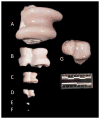Post-traumatic osteoarthritis of the ankle: A distinct clinical entity requiring new research approaches
- PMID: 27764893
- PMCID: PMC5467729
- DOI: 10.1002/jor.23462
Post-traumatic osteoarthritis of the ankle: A distinct clinical entity requiring new research approaches
Abstract
The diagnosis of ankle osteoarthritis (OA) is increasing as a result of advancements in non-invasive imaging modalities such as magnetic resonance imaging, improved arthroscopic surgical technology and heightened awareness among clinicians. Unlike OA of the knee, primary or age-related ankle OA is rare, with the majority of ankle OA classified as post-traumatic (PTOA). Ankle trauma, more specifically ankle sprain, is the single most common athletic injury, and no effective therapies are available to prevent or slow progression of PTOA. Despite the high incidence of ankle trauma and OA, ankle-related OA research is sparse, with the majority of clinical and basic studies pertaining to the knee joint. Fundamental differences exist between joints including their structure and molecular composition, response to trauma, susceptibility to OA, clinical manifestations of disease, and response to treatment. Considerable evidence suggests that research findings from knee should not be extrapolated to the ankle, however few ankle-specific preclinical models of PTOA are currently available. The objective of this article is to review the current state of ankle OA investigation, highlighting important differences between the ankle and knee that may limit the extent to which research findings from knee models are applicable to the ankle joint. Considerations for the development of new ankle-specific, clinically relevant animal models are discussed. © 2016 Orthopaedic Research Society. Published by Wiley Periodicals, Inc. J Orthop Res 35:440-453, 2017.
Keywords: PTOA; osteochondral injury; preclinical model; sprain; talocrural.
© 2016 Orthopaedic Research Society. Published by Wiley Periodicals, Inc.
Figures



References
-
- Richmond SA, Fukuchi RK, Ezzat A, et al. Are joint injury, sport activity, physical activity, obesity, or occupational activities predictors for osteoarthritis? A systematic review. J Orthop Sports Phys Ther. 2013;43:515–B19. - PubMed
-
- Brown TDT, Johnston RCR, Saltzman CLC, et al. Posttraumatic osteoarthritis: a first estimate of incidence, prevalence, and burden of disease. J Orthop Trauma. 2006;20:739–744. - PubMed
-
- Weatherall JM, Mroczek K, McLaurin T, et al. Post-traumatic ankle arthritis. Bull Hosp Jt Dis. 2013;71:104–112. - PubMed
-
- Wilson MG, Michet CJJ, Ilstrup DM, et al. Idiopathic symptomatic osteoarthritis of the hip and knee: a population-based incidence study. Mayo Clin Proc. 1990;65:1214–1221. - PubMed
Publication types
MeSH terms
Grants and funding
LinkOut - more resources
Full Text Sources
Other Literature Sources
Medical

